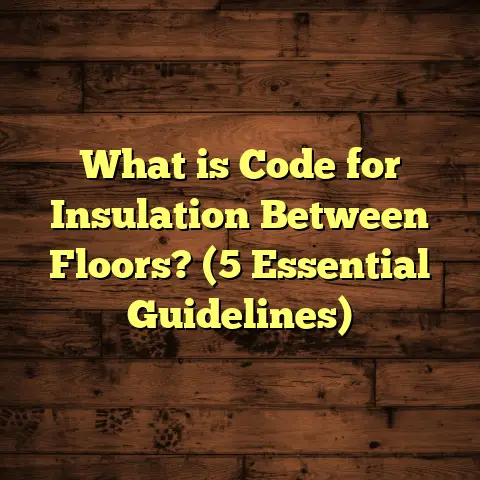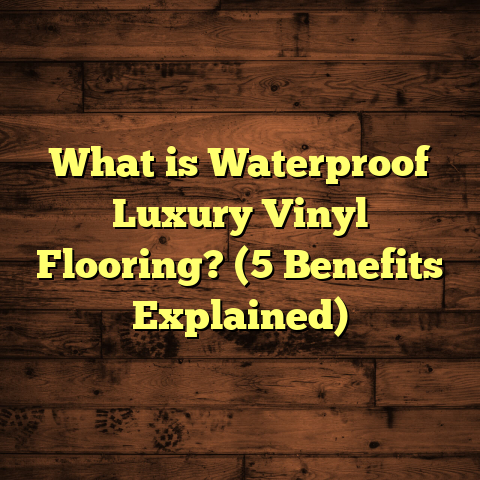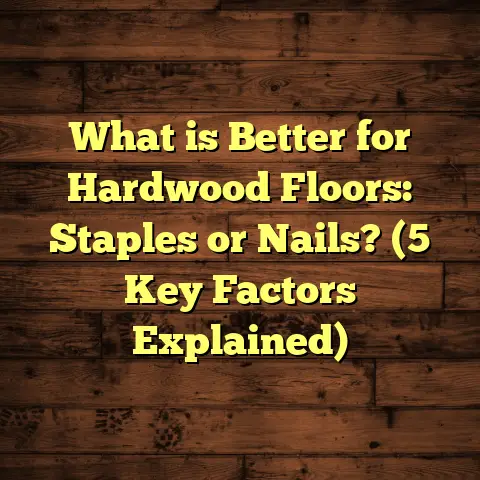What is Average Cost of Epoxy Garage Flooring? (5 Factors Explained)
Warning: Don’t Start Your Garage Flooring Project Without Knowing These Costs!
I learned this the hard way. When I was helping a friend redo his garage floor, we had no idea how much the epoxy coating would really set us back. The final bill was way higher than expected, and it left us scrambling to adjust the budget. If you’re thinking about epoxy garage flooring, you need to understand the costs before you get started—otherwise, you might end up in the same spot.
What is Epoxy Garage Flooring?
Epoxy garage flooring is a protective coating made from a mix of resin and hardener that forms a tough, durable surface when applied over concrete floors. It’s popular for garages because it can handle heavy loads, resist chemicals, and looks much better than bare concrete.
You might wonder: why epoxy? Well, epoxy floors don’t just improve the garage’s appearance; they also prevent cracks and dusting — common problems with untreated concrete. Plus, the glossy finish can reflect light, brightening the space.
I’ve installed epoxy floors myself and helped many clients with their projects. From my experience, epoxy floors vary widely in price based on materials, preparation needs, and installation methods. Let’s break down the five key factors that influence the average cost.
1. Size of Your Garage Space
The size of your garage plays a huge role in determining your total cost for epoxy flooring. Usually, garages range anywhere from 200 sq ft (one-car garage) to over 800 sq ft (large three-car garages or workshops). The larger the floor area, the more materials and labor are required, which means higher costs.
Why size matters so much
Imagine ordering paint: if you want to paint a small room versus a large hall, you’re going to need more paint and spend more time painting the bigger area. Epoxy application is similar. The amount of resin and hardener depends directly on square footage.
In my projects, I’ve noticed that smaller garages often have a higher price per square foot because there is a minimum charge for labor and materials. Larger spaces benefit from economies of scale — meaning the price per square foot often decreases as size increases.
Examples from my experience
- Small garage (250 sq ft): For a client with a compact one-car garage, using mid-grade epoxy, the total came to around $1,200. The price per square foot was about $4.80.
- Medium garage (500 sq ft): A typical two-car garage project I did cost about $3,000. That’s roughly $6 per square foot because we used higher quality epoxy and some decorative flakes.
- Large garage (800 sq ft): For a three-car garage with premium epoxy and metallic pigments, the bill hit nearly $9,000 — about $11 per square foot.
How to measure your space
If you’re unsure of your garage size, simply measure length × width in feet. Don’t forget to subtract areas covered by built-in cabinets or islands if you don’t plan to coat underneath.
2. Quality and Type of Epoxy Used
Not all epoxy coatings are created equal. The quality and type you pick have a big impact not only on price but also on durability and appearance.
Types of epoxy coatings
- Water-Based Epoxy: This is the cheapest option. It’s easy to apply but less durable and prone to yellowing over time. It’s best for light-duty garages or hobby spaces.
- Solvent-Based Epoxy: Offers better resistance to chemicals and scratches. Has a stronger smell during application due to solvents but provides a tougher finish.
- 100% Solids Epoxy: The highest quality epoxy available. It contains no water or solvents, so it cures very hard and lasts for years. This type is preferred for heavy-duty garages that see lots of use.
My take on different types
I’ve worked with all three types. Water-based epoxy is tempting because of its low price (around $2-$4 per sq ft), but I rarely recommend it for garages because it tends to chip after heavy use.
Solvent-based epoxies offer a nice middle ground in terms of durability and price ($4-$6 per sq ft). They work well for homeowners who want to protect their floor without breaking the bank.
My favorite is 100% solids epoxy. It costs around $6-$12 per sq ft but holds up under cars, tools, and spills for many years without peeling or fading.
How quality affects longevity
With cheaper epoxies, you might need to reapply every 2-3 years. High-quality epoxies last 10+ years with minimal maintenance. That difference alone can justify spending more upfront.
3. Surface Preparation Requirements
Here’s where many people get caught off guard: prepping your concrete floor properly can easily add 30-50% more to your project cost.
Why preparation matters
Epoxy sticks best to clean, dry, smooth concrete. If your garage floor has cracks, oil stains, or moisture issues, these must be addressed first or your epoxy won’t last.
I once had a client who skipped prep to save money. Within six months, large areas started peeling off — which meant ripping out the old coating and starting over at twice the original price.
Typical prep steps
- Cleaning: Removing dirt, grease, oil, and dust.
- Grinding: Using diamond grinders or shot blasting machines to roughen the surface so epoxy bonds well.
- Crack repair: Filling cracks with epoxy or cementitious fillers.
- Moisture testing: Ensuring concrete isn’t too damp (moisture can cause bubbling or peeling).
- Priming: Applying special primers if needed to improve adhesion.
Cost breakdown
Prep work varies widely by floor condition:
| Prep Task | Estimated Cost Per Sq Ft |
|---|---|
| Basic cleaning | $0.50 – $1 |
| Grinding | $1 – $3 |
| Crack repair | $0.50 – $2 |
| Moisture barrier | $1 – $3 |
If your floor is old or neglected with stains and cracks, expect prep costs closer to $4 per sq ft or even higher.
4. Labor Costs in Your Area
Labor prices are tied closely to where you live and who you hire. Contractors in big cities tend to charge more due to higher living costs and demand.
Regional differences
Here’s what I’ve observed from projects across the U.S.:
- Midwest: $3-$5 per sq ft for labor
- South: Around $3-$6 per sq ft
- West Coast & Northeast: Can range $6-$10 per sq ft
Labor includes surface prep, mixing epoxy properly, applying multiple coats evenly, and cleanup.
Should you DIY?
Doing your own epoxy floor can save money but comes with risks:
- Epoxy is sensitive; poor mixing or application leads to bubbles or uneven surfaces.
- Prepping concrete properly requires tools like grinders that can cost hundreds.
- Timing is critical; epoxy cures fast under certain conditions.
I helped a friend DIY his floor using water-based epoxy kits costing about $600 total for materials on 400 sq ft — but he spent nearly 40 hours over weekends prepping and applying.
If you’re confident in your skills and have time, DIY might be worth it for small garages.
5. Additional Features and Finishes
Want something beyond plain grey? Adding decorative flakes, metallic pigments, or anti-slip textures makes your floor unique but pushes up costs.
Decorative flakes
These small chips spread during application add color and texture — popular in garages that double as showrooms or workspaces.
Flake systems add about $1-$3 per sq ft because they require multiple coats for proper coverage.
Metallic epoxies
Metallic finishes create swirling color effects that look stunning but cost twice as much as standard epoxy due to expensive pigments and complex application.
I installed a metallic epoxy floor for a client wanting a “wow” factor in his garage workshop — total was about $9-$12 per sq ft on 600 sq ft.
Anti-slip additives
For safety, especially if your garage doubles as a gym or workshop, adding sand or grit particles helps prevent slips but adds small costs ($0.25-$0.75 per sq ft).
Breaking Down Average Costs With Real-Life Examples
Let’s look at some detailed case studies from my projects:
| Project | Size (sq ft) | Epoxy Type | Prep Level | Add-ons | Total Cost | Cost/Sq Ft |
|---|---|---|---|---|---|---|
| Small one-car garage | 250 | Water-based | Basic cleaning | None | $1,200 | $4.80 |
| Medium two-car garage | 500 | 100% solids | Moderate grind | Decorative flakes | $4,000 | $8 |
| Large three-car garage | 800 | Metallic epoxy | Extensive prep | Metallic pigments | $9,600 | $12 |
| DIY project | 400 | Water-based kit | Self prep | None | $600 (materials only) | $1.50 (materials only) |
Common Questions About Epoxy Garage Flooring Costs
Q: How long does epoxy flooring last?
A: High-quality epoxy floors can last 10-20 years if properly maintained.
Q: Can I apply epoxy over existing coatings?
A: Usually no. Old coatings must be removed via grinding or stripping for proper adhesion.
Q: Does humidity affect installation?
A: Yes! High moisture content in concrete can cause bubbling or peeling unless moisture barriers are used.
Q: Are epoxy floors slippery?
A: Plain epoxy can be slick when wet; adding anti-slip texture solves this issue.
My Personal Tips for Saving Money on Epoxy Floors
- Do thorough prep yourself: Cleaning and degreasing can be done by most homeowners.
- Buy quality materials but avoid over-specifying: Choose mid-range epoxies if heavy use isn’t expected.
- Get multiple quotes: Labor rates vary significantly; shop around.
- Consider DIY for small areas: If time allows and you’re handy.
- Plan for maintenance: Keep your floor clean and avoid harsh chemicals to extend life.
Wrapping Up My Thoughts on Epoxy Garage Flooring Costs
From my years installing floors and helping friends with their garages, I know budgeting upfront saves headaches later. The average cost depends mostly on size, epoxy quality, surface prep needs, labor rates, and any extras like decorative finishes.
Spending wisely on preparation and good materials pays off in durability and appearance. And don’t underestimate labor — good installers make all the difference.
If you want personalized advice or help estimating your project based on location and garage size, just let me know! I’m here to help you plan smart so your garage looks great without breaking the bank.
If you have questions or want me to help estimate your project cost in detail—just ask! I’m happy to share what I’ve learned over the years so you avoid costly surprises like I once faced when helping my friend redo his garage floor.





